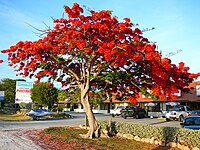
Photo from wikipedia
Abstract This study focused on the comparative analysis of biosorption performance of Delonix regia seed pod toward the removal of Rhodamine B (RB) from simulated solution using native (DRSP) and… Click to show full abstract
Abstract This study focused on the comparative analysis of biosorption performance of Delonix regia seed pod toward the removal of Rhodamine B (RB) from simulated solution using native (DRSP) and chemically treated form (ADRSP). The surface morphology, structural analysis, textural properties, and thermal analysis of DRSP and ADRSP were examined using scanning electron microscopy (SEM), BET analysis, Fourier transform infrared spectroscopy (FTIR), and thermogravimetric analysis (TGA), respectively. FTIR analysis concluded that surface functional groups like hydroxyl –OH stretching, C–N stretching, and C = C stretching of the aromatic ring were largely responsible for the attachment of RB. The chemical treatment enhanced the surface morphology of D. regia seed in terms of heterogeneity, distinct depth cavities, and irregular pores responsible for RB biosorption. The biosorption of RB was investigated using parametric analyses such as solution pH, biosorbent dosage, contact time, initial RB concentration, and operating temperature. The obtained equilibrium data were fitted with different isotherm and kinetic models. Langmuir isotherm model and pseudo-second-order kinetic were well suitable for the biosorption of RB using DRSP and ADRSP. The maximum monolayer biosorption capacities (mg/g) of DRSP and ADRSP were predicted to be 39.37 and 60.61, respectively. Using thermodynamic principles, the removal of RB was found to be thermodynamically feasible, endothermic, and spontaneous process. The results of the present study proved that DRSP and ADRSP can be identified as promising biosorbents for the removal of RB. NOVELTY STATEMENT The potential utilization of Delonix regia seed pod (native and chemically treated forms) for the removal of Rhodamine B (RB) from simulated water. Surface morphology, surface area, functional analysis, and thermal analysis of both native (DRSP) and treated forms (ADRSP) to understand materials properties before biosorption of RB. Parametric effects of dosage, initial pH, initial pollutant concentration, and temperature on biosorption capacity and biosorption (%) using native and treated forms of bisorbents. Implantation of different kinetic models and two-parameter isotherm models to examine the feasibility and type of biosorption. The maximum biosorption capacity (mg/g) of DRSP and ADRSP is predicted to be 39.37 and 60.61 using the Langmuir isotherm model, respectively. Identification of possible biosorption mechanism using the functional group analysis. Negative values of Gibbs free energy change ( and positive values of entropy change ( enthalpy change ( demonstrating the thermodynamic feasibility, increase in randomness at the solid-liquid interphase and endothermic biosorption
Journal Title: International Journal of Phytoremediation
Year Published: 2022
Link to full text (if available)
Share on Social Media: Sign Up to like & get
recommendations!